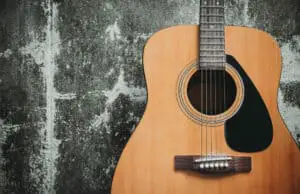
Are you one of those people who think anyone can learn to play the guitar if they just put their mind to it? Well, I suppose you might be wrong. Playing the guitar is a skill that must be learned and practiced, just like any other skill.
And if you’re considering becoming a guitar teacher, you need to know how to teach guitar correctly.
As a guitar teacher, one of the most important things you should do is ensure that your students learn the techniques they want. You can teach them how to hold the guitar, make basic chords, strum, fingerpick, and read tablature (guitar tabs).
By the end of this article, you have learned how to teach guitar the right way, the importance of quality practice, some tips for using social media, and whether or not teaching guitar is a profitable business.
-
How To Teach Guitar
- 1. Start With Simple Techniques
- 2. Listen to What Your Student Wants To Learn
- 3. Adapt Your Teaching Style To Each Student
- 4. How To Hold the Guitar
- 5. How To Make Basic Chords
- 6. Strumming Techniques
- 7. Fingerpicking Techniques
- 8. How To Read Tablature
- 9. How To Find Chords in Songs
- 10. Use Social Media
- 11. Focus on Quality Practices and Avoid Theoretical Teaching
- Is Teaching Guitar a Profitable Business?
- The Bottom Line
How To Teach Guitar
Teaching guitar can be a very rewarding experience. It is a great way to share your love of music with others and help them develop their own musical skills.
There are a few things to keep in mind when teaching guitar; however, that will help ensure your lessons are effective and enjoyable for you and your students.
1. Start With Simple Techniques

Many people who are new to playing the guitar make the mistake of trying to learn too many techniques at once. This can be overwhelming and cause them to give up before they’ve even started.
As a guitar teacher, you should start by teaching your students simple techniques that they can master before moving on to more complex ones. For example, you can teach them how to hold the guitar, make basic chords, and strum.
Once they’ve mastered these basic techniques, you can move on to more advanced ones such as fingerpicking and reading tablature.
2. Listen to What Your Student Wants To Learn

One of the most important things you can do as a guitar teacher is listen to what your students want to learn. This will help you tailor your lessons to their specific needs and interests.
For example, if your student wants to learn how to play rock guitar, then you should focus your lessons on teaching them the techniques they need to play rock guitar.
3. Adapt Your Teaching Style To Each Student

Not all students learn the same way, so you must adapt your teaching style to each student. Some students may be visual learners, so they learn best by watching you play. Other students may be auditory learners, so they learn best by listening to you explain things.
And still, other students may be kinesthetic learners, and they learn best by doing. It’s essential to find out what type of learner your student is and then adapt your teaching style accordingly.
4. How To Hold the Guitar

The first thing you need to do is teach your students how to hold the guitar. There are two main ways to do this:
The best way is to have them sit in a chair with the guitar placed so that the strings are facing away from their body. The neck of the guitar should be resting on their left leg, and their right arm should be wrapped around the body of the guitar.
Once they’ve learned how to hold the guitar, you can then move on to teaching them how to make basic chords.
5. How To Make Basic Chords

One of the most important things you need to teach your students is how to make basic chords. Chords are the building blocks of guitar playing, so your students must learn how to make them.
There are many ways to make chords, but the easiest way is to use “barre chords.” Barre chords are made by holding down two or more strings with one finger.
For example, the A chord is made by holding down the second fret of the sixth string with your first finger and the second fret of the fifth string with your second finger.
To make the E chord, you hold down the second fret of the fourth string with your first finger and the second fret of the third string with your second finger.
Now, you can move forward to teach your students strumming techniques.
6. Strumming Techniques

Strumming is the basis of rhythm guitar playing, so your students must learn how to do it. There are many different strumming patterns, but the most important thing is that your students learn how to keep a steady beat.
One of the best ways to do this is to have them practice strumming along with a metronome. As your students become more proficient at guitar playing, you can teach them more advanced techniques such as fingerpicking and reading tablature.
7. Fingerpicking Techniques

You can teach your students guitar fingerpicking techniques in a few different ways. The first way is to show them how to do it yourself. You can demonstrate the techniques and then have them follow along.
Another way to teach guitar fingerpicking techniques is to use video lessons. There are plenty of excellent fingerpicking guitar lessons available online. You can either use these as a supplement to your own teaching or can have your students watch them on their own time.
Finally, you can find some great fingerpicking guitar exercises in guitar magazines or online. These can be a great way to help your students learn the techniques.
Whatever method you choose, ensure that you are patient and consistent with your teaching. Your students will need time to master the techniques, but they will eventually get there with practice.
8. How To Read Tablature

You should teach your students to read tablature.
Some students prefer to learn by ear, while others may find it easier to learn from a written method. If you’re unsure which method to use, you can always try a combination.
You can start teaching your students how to read tablature by having them listen to a recording of the song you’re trying to teach them. As they listen, they can follow along with the tablature. This is a great way for them to get a feel for the song and how it should be played.
Secondly, you can teach your students to read tablature using a method called “chord families.” This method is based on the fact that most songs are built around a few basic chords.
By teaching your students the different chord families, they’ll be able to quickly and easily identify the chords in a song, even if they’ve never heard it before.
9. How To Find Chords in Songs

There’s no definitive answer to this question – ultimately, it depends on the learning style of your students and what suits them best. However, a few general tips can help make finding chords in songs easier for your students.
One helpful tip for finding chords in songs is to listen for the chord progressions. A chord progression is simply a sequence of chords played in a song. By listening for the chord progressions, your students can better understand how the song is structured and where the chords are located.
Another tip is to look for the melody of the song. The melody often provides clues as to what chords are being played. If your students can identify the melody, they may be able to figure out the chords more easily.
10. Use Social Media

Social media can be a great way to connect with other guitar teachers and share resources. There are many different social media platforms that you can use, such as Facebook, Twitter, and Instagram.
You can use social media to post helpful articles, share instructional videos, or even answer questions from your students. It will expand your reach as a guitar teacher and help you connect with more students.
11. Focus on Quality Practices and Avoid Theoretical Teaching

There is no substitute for quality practice when it comes to learning guitar. Your students will need time and effort to master the techniques and build up their skills.
One way to ensure that your students get quality practice is to teach them how to practice effectively. This means showing them how to break down songs and techniques into manageable pieces and then giving them specific goals to work on.
Another way to ensure quality practice is to avoid excessive theoretical teaching. While your students need to understand the theory behind what they’re playing, they won’t make progress if they’re constantly bogged down by theory.
Keep the theory to a minimum and focus on helping your students develop their skills through quality practice.
Is Teaching Guitar a Profitable Business?
Yes, teaching guitar can be a profitable business. You can generate revenue by charging for private lessons, group lessons, or by teaching at a music school.
You can also generate revenue by selling guitar-related products, such as instructional books or online courses.
To make a profit, you must keep your overhead costs low and focus on marketing your business.
The Bottom Line
Teaching guitar can be a rewarding experience for you and your students. It can also be a great way to make some extra money. Make your passion your profession and see what wonders life offer you in the future.
With some planning and effort, you can succeed in the guitar teaching business.









